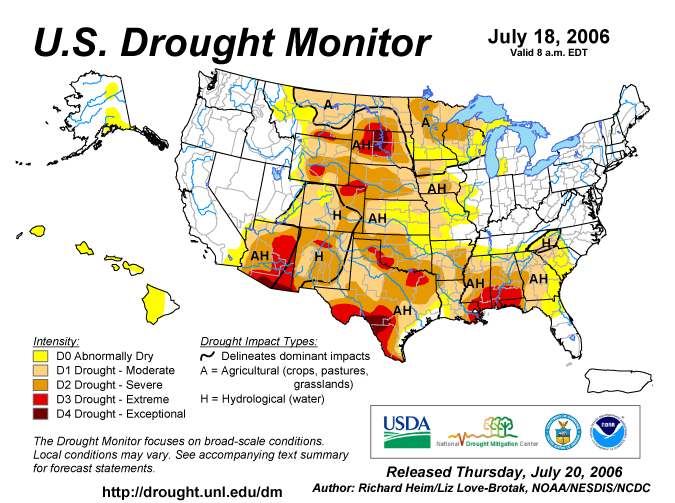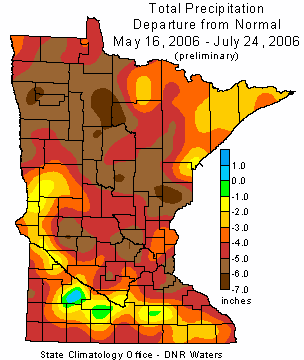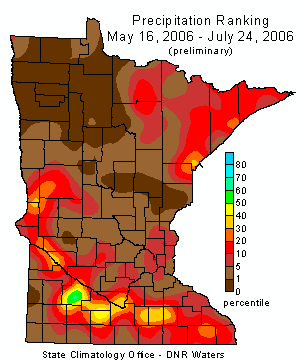Drought Situation Report - July 26, 2006
More drought information resources are found at http://climate.umn.edu/doc/journal/dry_summer_2006.htm.

Weather this past week:
Rainfall for the past week (map on right) was plentiful in some areas of south central and southeastern Minnesota. However,
the rain was not widespread and did little to alleviate Minnesota's rapidly developing drought conditions in the northern one half of Minnesota.
Welcome rain fell on July 19, 2006 and was focused primarily on south central and southeastern Minnesota.
Martin and Faribault counties were among the drier places in the southern half of the state. The two to four
inch rain in these counties on the 19th was beneficial to agricultural interests. Another streak of heavier rain, roughly
from Mankato to Rochester, fell upon an area that has been somewhat better off than the rest of southern
Minnesota. On July 23 and 24, welcome rains also drifted across northeastern Minnesota and dropped over an inch in some areas.
Temperatures for the week across Minnesota averaged one to three degrees above normal, but the oppressive heat of July 14 and 15 was not repeated. During the evening hours of July 25th, heavy rains fell over northwest to east central Minnesota. While the rains were heavy, the coverage was rather spotty. Nonetheless, some places that needed ran badly did get some appreciable amounts such as Brainerd with .61 inches and Wild River State Park with 2.22.
Seasonal weather overview:
Dryness has been entrenched in Minnesota for ten weeks. Large-scale, precipitation-producing weather systems have been absent
since mid-May. For much of this time, Minnesota has been under the influence of weak northwesterly flow in the upper atmosphere. During
the summer, such a weather pattern leads to geographically-isolated and short-lived showers and thunderstorms. The timing of the dry weather
has been most unfortunate. The period from late-May into mid-July is historically one of the wettest times of the year. Long-term average
rainfall rates during this time interval are around one inch per week. Very dry weather occurring during a time of year when ample rain is
typical, led to the rapid onset of drought. The precipitation shortfalls have led to deteriorating crop conditions, low stream flows,
and increased wildfire danger.

Drought status:
The latest National Drought Mitigation Center Drought Monitor released Thursday, July 20, places northwestern, central, and east central Minnesota in the "Severe Drought" category. All other Minnesota locations, with the exception of southern Minnesota, are depicted in the "Moderate Drought" classification. Southern Minnesota is depicted in the "Abnormally Dry" classification. Possible impacts for landscapes depicted as experiencing "Severe Drought" include: "Crop or pasture losses likely; water shortages common; water restrictions imposed". Possible impacts for landscapes depicted as experiencing "Moderate Drought" include: "some damage to crops, pastures; streams, reservoirs, or wells low, some water shortages developing or imminent; voluntary water-use restrictions requested". The next Drought Monitor will be released on Thursday, July 27. Without significant, wide-spread rain, many areas of Minnesota will either maintain or experience worsening drought conditions. The rains that fell across southern Minnesota on July 19th, will help the southern counties.
Sector briefs:
Agriculture - The Agricultural Statistics Service reports that topsoil moisture for 75% of Minnesota's
landscape is now "Short" or "Very Short". This percentage is nearly the same a week ago with some improvement in south central Minnesota. Minnesota's
corn crop is in the midst of its critical reproductive stages. Heat and moisture stress during this period leads to significant yield loss.
Stream flow - Stream flow in one half of Minnesota's rivers and streams falls below the 25th percentile
when compared with historical data. Flow conditions in many northern and eastern Minnesota watersheds have dropped below the "Protected
Flow" threshold (lowest 10th percentile), leading the Department of Natural Resources to suspend surface water appropriation permits in these areas.
Public water supply - Many Minnesota communities are imposing watering restrictions or outright watering bans.
Wildfire - Wildfire danger is "High" or "Very High" in northern and central Minnesota counties. The
Cavity Lake Fire in the BWCA area of the Superior National Forest is reported at 31,850 acres as of July 25.
A half an inch of rain or more fell over the fire area on July 23, aiding fire suppression.
Ten-week precipitation totals, departure, and ranking:
Rainfall totals over the past ten weeks were less than four inches in many counties and less than three inches across much of northwestern Minnesota.
Ten-week rainfall totals deviated negatively from historical averages by more than three inches in most areas. Rainfall deficits
exceeded five inches in portions of northwest, central, and southeast Minnesota. When compared with other May 16 to July 24 rainfall
totals in the historical database, this year's rainfall totals for the period rank among the lowest on record in some locales.
The situation is especially acute in northwest Minnesota where near-record low precipitation totals are common across a multi-county area.
Previous Drought Situation Report (July 21)
Previous Drought Situation Report (July 11)
More drought information resources are found at http://climate.umn.edu/doc/journal/dry_summer_2006.htm.

 Return to Minnesota Climatology Working Group Main page
Return to Minnesota Climatology Working Group Main page
Error processing SSI file
URL: http://climate.umn.edu/doc/journal/drought_situation_report_2006_060726.htm
Last modified: July 26, 2006
|





 Return to Minnesota Climatology Working Group Main page
Return to Minnesota Climatology Working Group Main page